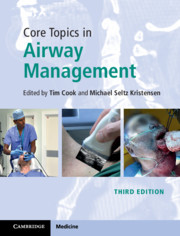Book contents
- Core Topics in Airway Management
- Core Topics in Airway Management
- Copyright page
- Contents
- Contributors
- Foreword
- Preface to the Third Edition
- Section 1 Airway Management: Background and Techniques
- Section 2 Airway Management: Clinical Settings and Subspecialties
- Chapter 22 The Airway in Obstetrics
- Chapter 23 The Paediatric Airway
- Chapter 24 Airway Management in Obesity
- Chapter 25 Maxillofacial and Dental Surgery
- Chapter 26 Ear, Nose and Throat Surgery: Airway Management
- Chapter 27 Lung Separation
- Chapter 28 Airway Management in the Critically Ill
- Chapter 29 The Patient with a Tracheostomy
- Chapter 30 Pre-hospital and Trauma Airway Management
- Chapter 31 Airway Management during CPR
- Chapter 32 The Bloody and Bleeding Airway
- Chapter 33 The Airway in Anaesthesia for Transoral Robotic Surgery
- Section 3 Airway Management: Organisation
- Index
- References
Chapter 25 - Maxillofacial and Dental Surgery
from Section 2 - Airway Management: Clinical Settings and Subspecialties
Published online by Cambridge University Press: 03 October 2020
- Core Topics in Airway Management
- Core Topics in Airway Management
- Copyright page
- Contents
- Contributors
- Foreword
- Preface to the Third Edition
- Section 1 Airway Management: Background and Techniques
- Section 2 Airway Management: Clinical Settings and Subspecialties
- Chapter 22 The Airway in Obstetrics
- Chapter 23 The Paediatric Airway
- Chapter 24 Airway Management in Obesity
- Chapter 25 Maxillofacial and Dental Surgery
- Chapter 26 Ear, Nose and Throat Surgery: Airway Management
- Chapter 27 Lung Separation
- Chapter 28 Airway Management in the Critically Ill
- Chapter 29 The Patient with a Tracheostomy
- Chapter 30 Pre-hospital and Trauma Airway Management
- Chapter 31 Airway Management during CPR
- Chapter 32 The Bloody and Bleeding Airway
- Chapter 33 The Airway in Anaesthesia for Transoral Robotic Surgery
- Section 3 Airway Management: Organisation
- Index
- References
Summary
This chapter gives a presentation of the major issues to consider in maxillofacial and dental surgery when sharing the airway with the surgeon. It is essential to have knowledge of the surgical population and procedures to plan the airway handling safely to avoid potential complications. Nasal intubation gives optimal access for the surgeon and is the gold standard but is accompanied with the risk of nasal trauma. Manoeuvres to minimise complications are given. There are different considerations to take into account both for the well-planned scheduled procedure and for the urgent procedure with a threatened airway. Surgical complications such as bleeding and infection challenge the skills of the anaesthetist making the airway handling difficult. Awake flexible optical bronchoscope-guided intubation is a safe option and a plan for extubation must be made. A structured approach to handle the patient with maxillofacial trauma is given both in the emergency case and later for final surgery. Priority and timing of surgery is crucial in the patient with multiple injuries, and especially the neurotrauma patient with respect to control of intracranial pressure.
Keywords
- Type
- Chapter
- Information
- Core Topics in Airway Management , pp. 214 - 222Publisher: Cambridge University PressPrint publication year: 2020



